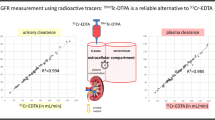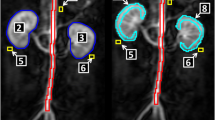Abstract
In order to estimate the normal range of chromium-51 ethylene diamine tetra-acetic acid (EDTA) clearance in children, we selected a series of 256 patients with past or present urinary tract infection who showed, at the time of the clearance determination, normal technetium-99m dimercaptosuccinic acid (DMSA) scintigraphy and normal left to right DMSA relative uptake. The clearance was calculated by means of either the simplified second exponential method or the 120-min single blood sample; Chantler's correction was used in order to correct for having neglected the first exponential. There was a progressive increase in clearance from the first weeks of life (mean value around 1 month: 55 ml/min/1.73 m2), with a plateau at around 18 months. Between 2 and 17 years of age, the clearance values remained constant, with a mean value of 114 ml/min/1.73 m2 (SD: 24 ml/min); this is similar to the level described for inulin clearance. No significant differences were observed between boys and girls, or between clearance values calculated with one or with two blood samples. Taking into account the hour of intravenous injection of the tracer, we did not observe any influence of the lunchtime meal on the distribution of the 51Cr-EDTA clearance values.
Similar content being viewed by others
References
Dodge WF, Travis LB, Daeschner CW. Comparison of endogenous creatinine clearance with inulin clearance. Am J Dis Child 1967;113: 683–685.
Kassirer JP. Clinical evaluation of kidney function- glomerular function. N Engl J Med 1971;285: 385–389.
Guignard JP, Torrado A, Feldman H, Gautier E. Assessment of glomerular filtration rate in children. Helv Paediatr Acta 1980;35: 437–447.
Chantler C, Garnett ES, Parsons V, Veall N. Glomerular filtration rate and measurement in man by the single injection method using 51Cr-EDTA. Clin Sci 1969;37: 169–180.
Bröcbner-Mortensen J. Routine methods and their reliability for assessment of glomerular filtration rate in adults. Dan Med Bull 1978;25: 181–202.
Chantler C, Barrett TM. Estimation of glomerular filtration rate from plasma clearance of 51 chromium edetic acid. Arch Dis Child 1972;47: 613–617.
Ham HR, Piepsz A. Estimation of glomerular filtration rate in infants and children using a simple plasma sample method. J Nucl Med 1991;32: 1294–1297.
Barratt TM, Chantler C. Laboratory evaluation. In: Rubin MI, Barratt TM, eds. Paediatric nephrology. Baltimore: Williams and Wilkins;1986: 282–299.
Stokland E, Hellström M, Jodal U, Lundgren P, Sixt R. DMSA scintigraphy in children with acute first time urinary tract infection. Eur J Nucl Med 1992;19: 629.
Piepsz A, Tamminen-Möbius T. Correlation between scintigrphic lesions and renal scarring in intravenous urogram in children with normal relative uptake of DMSA and evaluation of normal kidney findings of DMS scan. In: Blaufox, Hollenberg, Raynaud, eds. Radionuclides in nephrology. Basel: Karger;1990: 147–155.
Jakobsson B, Süderlundh S, Berg U. Diagnostic significance of 99mTc-dimercaptosuccinic acid (DMSA) scintigraphy in urinary tract infection. Arch Dis Child 1992;67: 1338–1342.
Jakobsson B, Nolstedt L, Svensson L, Söderlundh S, Berg U. 99mTc-DMSA scan in the diagnosis of acute pyelonephritis in children: relation to clinical and radiological findings. Pediatr Nephrol 1992;6: 328–334.
Berg UB. Renal dysfunction in recurrent urinary tract infections in childhood. Pediatr Nephrol 1989;3: 9–15.
Berg UB. Long term follow up of renal morphology and function in children with recurrent pyelonephritis. J Urol 1992;148: 1715–1720.
Smith HW. The kidney structure and function in health and disease. New York: Oxford University Press,1951.
Piepsz A, Hall M, Ham HR, Verboven M, Collier F. Prospective management of neonates with pelviureteric junction stenosis. Scand J Urol Nephrol 1989;23: 31–36.
Raynaud C. Valeurs normales de la fixation du Hg chez l'enfant ágé de moins de 4 ans. In: Raynaud C, ed. La fixation rénale du mercure et du DMSA. CEA;1976: 146–149.
Gordon I, Evans K, Peters AM. The quantitation of 99mTc-DMSA in paediatrics. Nucl Med Commun 1987;8: 661–670.
Bröchner-Mortensen J, Haahr J, Christoffersen J. A simple method for accurate assessment of the glomerular filtration rate in children. Scand J Clin Lab Invest 1974;33: 139–143.
Piciotto G, Cacace G, Cesana P, Mosso R, Ropolo R, De Filippi PG. Estimation of chromium-51 ethylene diamine tetra-acetic acid plasma clearance: a comparative assessment of simplified techniques. Eur J Nucl Med 1992;19: 30–35.
Author information
Authors and Affiliations
Rights and permissions
About this article
Cite this article
Piepsz, A., Pintelon, H. & Ham, H.R. Estimation of normal chromium-51 ethylene diamine tetra-acetic acid clearance in children. Eur J Nucl Med 21, 12–16 (1994). https://doi.org/10.1007/BF00182300
Revised:
Issue Date:
DOI: https://doi.org/10.1007/BF00182300




